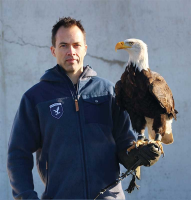DRONE PREDATORS
PHOTO // Courtesy of ST Electronics & Guard From Above
From designing machines to training eagles, companies are coming up with different ways to counter potentially hostile drones.
Imagine an unauthorised drone approaching a key installation. As the unmanned aircraft hovers over the fence, its signal is suddenly jammed. The drone is forced to beat a hasty retreat.
The popularity of Unmanned Aerial Vehicles (UAVs) has taken flight in recent years and its vast applications for security, commerce, leisure and even agriculture have attracted many enthusiasts. Other uses of UAVs include aerial surveys, photography and media production.
While drones provide many benefits, they can also pose serious threats to public safety and security. Unauthorised intrusions and aerial delivery of hazardous materials and explosives are examples of dangerous usage, especially in an urban environment like Singapore.
The Sky Archer Counter Micro-UAV System (left) is a locally developed solution to neutralise hostile and illegal drones within a 1km radius.
UAV repellant
This is where the Sky Archer Counter Micro-UAV System comes in. Developed by Singapore Technologies (ST) Electronics, the technology can be used by homeland security agencies to watch over a specific area where UAVs are not permitted.
It is akin to ground-based air defence systems, albeit on a much smaller scale. The dome-shaped system uses electronic means to repel renegade UAVs. Potential applications include protection of key installations, border surveillance and counter-smuggling operations.
"Our system is developed based on open architecture, making it highly scalable to meet the varied operational needs of public safety and security agencies," said President of ST Electronics (Info-Comm Systems) Andrew Chow.
For instance, it can be upgraded to work with suitable radar sensors for longer range detection, or Electro-Optic sensors for day and night operations.
He added: "Depending on the size and shape of the area to be protected, multiple systems can be deployed to provide a suitable 'drone fence' to suit the required operational needs."
Detect, track, disable
To handle drone threats in an urban and radio-frequency dense environment, the Sky Archer is equipped with a visual detection module and an electronic sub-unit to detect, track, classify and electronically disable the threats up to a radius of 1km.
Since the idea was conceived two years ago, developments and tests have been ongoing to improve the robustness of the system s detection and denial capabilities.
The Sky Archer is portable and it uses a tripod mount set-up. This allows it to be mounted on a stationary vehicle or deployed at a fixed location. It also has the ability to disable multiple drones entering its protection perimeter.
According to ST Electronics, the system will be ready from June this year.
GFA Co-Founder and head instructor Ben de Keijzer with a bald eagle, one of the species trained to disarm drones.
Eagle-eye
In another approach, Dutch company Guard From Above (GFA) has been training eagles to take down drones. The agile eagle, an apex predator in its natural habitat, is the natural choice when it comes to countering unwanted drone traffic.
The idea of using eagles to catch drones came from its Chief Executive Officer, Mr Sjoerd Hoogendoorn. The company has been doing research on drone-related incidents and possible counter-measures for the last couple of years.
Calling it a low-tech solution to a high-tech problem, Mr Hoogendoorn explained that birds of prey have natural hunting instincts to overpower fast-moving prey that makes them uniquely suitable to intercept drones. It is the first commercial company to provide this capability.
"Two of the most impressive characteristics of birds of prey are their speed and their power," said Mr Hoogendoorn. "They use their strength and speed when they hunt: they are the masters of the air. Sometimes the solution to a hyper-modern problem is more obvious than you might think."
Predator instincts
The eagles are trained under the GFA Bird Training Programme for about a year before they are put to work. They are taught to recognise drones as prey; they snatch a drone with their talons in mid-air and bring it to a safe place.
This concept uses their natural instinct of subjugating prey. After each successful interception, the eagles will be awarded with a piece of meat.
While the maximum weight of a drone that a bird of prey can carry has not been revealed, their scaly talons are strong and tough enough to seize most drones without being injured by the blades. In the wild, eagles have been observed flying with prey (usually fish) weighing between two to three kilogrammes.
Mr Hoogendoorn explained: "In nature, birds of prey often overpower large and dangerous prey. Their talons have scales, which protect them, naturally, from their victims' bites."
GFA is working closely with the Dutch National Police to bring this solution into practice and Mr Hoogendoorn revealed that, with the current promising results, the birds can expect to go operational in a couple of months. Once proven successful, the company will also be extending its partnership to national and international government security agencies.
Since April, GFA has been taking pre-orders for GFA-trained birds of prey from government agencies. They will also be starting a GFA Birdhandler Training Programme for government staff to learn to work with these birds.










